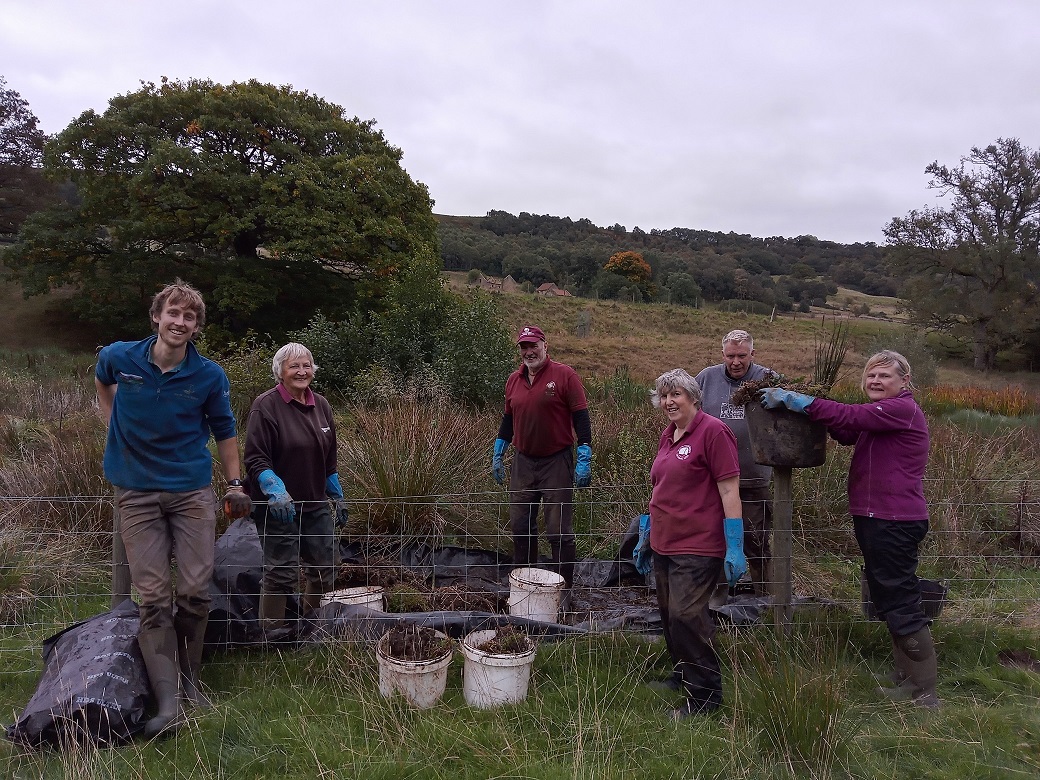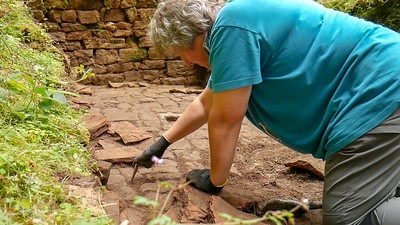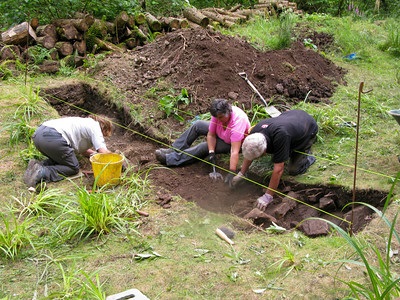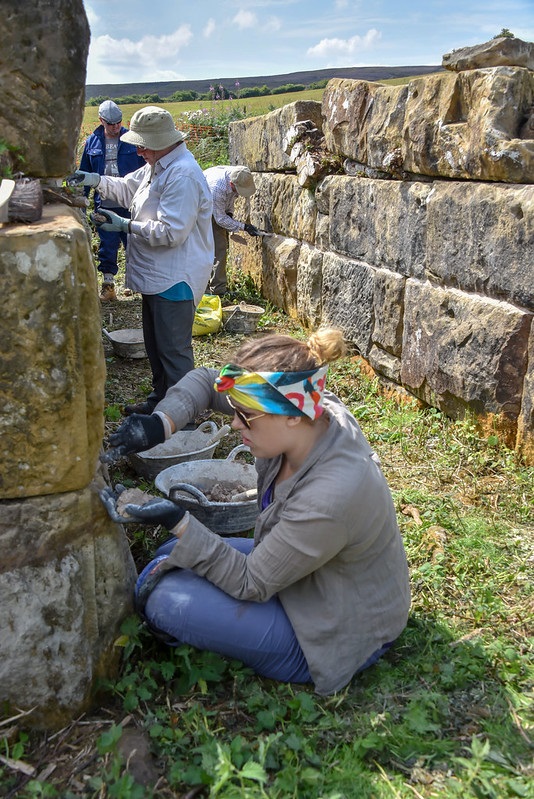National Park staff work on a wide variety of projects, often with the help of volunteers and partner organisations, to care for the things which make the North York Moors special, and to encourage and enable people to understand and enjoy what it has to offer.
These projects, which tend to be majority-funded through external grants, often create new and exciting opportunities for volunteers to get involved with our work. Moreover, many of these projects simply would not achieve the great things that they do if it were not for the work of volunteers. Here you can find examples of how volunteers are contributing to current projects in the North York Moors, as well as how they've helped us with projects in the past.
To find out what opportunities are currently open to new volunteers, please visit our Current opportunities page.
Birds on the edge (2022-2026)
Birds on the Edge is a National Lottery Heritage Funded project, led by the North York Moors National Park Trust, working to conserve and increase populations of redstart, song thrush, turtle dove and yellowhammer – birds that thrive ‘on the edge’ of habitats.
Over four years the project will:
- Work with land managers and communities to create and restore habitats
- Deliver an engagement programme to reconnect young people with nature
- Engage more people in practical conservation
- Make international links with schools on the birds’ migratory path
Volunteers are already involved with the project and currently out surveying landscapes and habitats. Over the coming years, there will be opportunities for volunteers to get involved in activities including bird surveys, bio-acoustic surveys, bird box building, and pond works. Keep an eye on our Current opportunities page for more information.
Ryevitalise (2019 - 2025)
'Ryevitalise' is a £3.4 million Landscape Partnership Scheme supported by The National Lottery Heritage Fund, North York Moors National Park Authority and partners, and inspired by local communities. To find out more about how Ryevitalise, you can visit the Nature Recovery area of our website. We've already run a number of successful Ryevitalise volunteering projects. Outcomes have included: Twenty-two volunteers have taken part in this project, recording 167 days’ worth of volunteering, analysing 153km of LiDAR squares. The consultant has highlighted three sites of interest; a Neolithic long barrow, potential Roman farm stead and extensive bronze age field cairns. We will now begin the process of investigating these further through field walk over surveys, with existing LiDAR volunteers taking the lead on the investigations. Five volunteers have taken part in this project, recording 30 oral histories using everything from Zoom, phone calls and socially distance interviews in participants own back gardens! These histories are now being used in the classroom at Ryedale School, with English classes using them as inspiration to write their experiences of living and playing in the local area. To find out more, please visit the 'Rediscovering the Rye's past' page of our website. An exciting addition to Ryevitalise has been the bat monitoring scheme. This citizen science project saw members of the public place ‘wildlife acoustic detectors’ within the River Rye catchment and then return after four nights to collect the detector and upload the data. The research is at the forefront of wildlife acoustic detection and is part of an innovative national study being led by the British Trust of Ornithology (BTO). In 2022, recordings were made over seven months and a total of 160 nights. Between the detectors, more than 581,000 recordings were collected and following analysis these were found to include 278,447 confirmed bat recordings and 427 small terrestrial mammal recordings. Digging down further, experts have confirmed the presence of at least nine different bat species, three small mammal species (or species groups, such as types of shrew), one bush-cricket species and two audible moth species. The best news is that the elusive Alcathoe bat (Myotis alcathoe) was recorded in the area again, and also the first evidence of Leisler’s Bat (Nyctalus leisleri) for the project. The data will be used to develop a deeper knowledge of bat populations in the Rye catchment area and to help inform on the ground habitat management and conservation decisions. The Land of Iron project ran between 2016 and 2021. It protected and conserved some of the most iconic monuments of the National Park and worked with land managers to nurture the natural environment. It also documented and told the stories of what life was like for communities during what was a short but intense period of ironstone mining, railway construction and industrial growth in the North York Moors. You can find out more about the project on our Land of Iron page. More then 300 volunteers contributed a total of 3,913 days during the project. Their amazing contributions included: Combs Wood - Combs Wood, Beck Hole was the site of two community digs for the Land of Iron project, a very wet one in May 2017, followed by a much brighter and more successful attempt in July 2018. The amount achieved in 10 days was astounding and a credit to the work ethic of our volunteers. Not only did they shift tonnes of soil and stone they assisted with the public tours, and provided knowledge and insights which helped establish a greater understanding of the site. Without them the excavation would just not have been possible. Warren Moor Mine - Five Land of Iron volunteers and two members of staff investigated two trenches dug across the ditch on the site. Most of the findings from the trenches were in line with previous excavations, however on the last day of the dig a volunteer discovered a previously unknown building! Adrian Glasser, a particularly tech-minded volunteer, produced a number of blog entries on his adventures in making practical and digital tools for the Land of Iron project. The North York Moors National Park Authority was a key partner in the Slowing the Flow Project, the aim of which was to help reduce the risk of flooding to the town of Pickering and surrounding areas. This project took a new approach to flood management by making changes to the way the landscape and catchment is managed. The project was active between 2009 and 2015 but management and monitoring is ongoing. To protect sensitive soils from disturbance and reduce rapid runoff, more than 8,500 trees were planted in 2011 and 2013, and nearly half of these by volunteers. Over the last decade, these trees (the majority of which were oaks grown from locally-collected acorns) have grown and flourished and so the benefits of this fantastic volunteer effort can truly be appreciated.
LiDAR Landscapes
Rye reflections oral history project
Bat surveyors
Land of Iron (2016 - 2021)
Community digs


Lime mortaring
 For five days in August 2018, a group of very determined Land of Iron volunteers and staff, along with one local lime mortar expert, descended on Warren Moor Mine in Little Kildale to begin conservation work. During the 144 years since the mine closure, tree roots, vegetation, insects and the weather had slowly eroded the site of Warren Moor Mine which includes a winding engine bed. The stonework had very little remaining mortar, and so we took on the task to re-point in order to help protect this historic structure. The task started with a day of training from local expert Nigel Copesy, followed by a further four days putting that new knowledge into action. The result was winding engine bed significantly more protected. Conserving our industrial heritage is hugely important, especially with a site like Warren Moor which provides a snapshot in time.
For five days in August 2018, a group of very determined Land of Iron volunteers and staff, along with one local lime mortar expert, descended on Warren Moor Mine in Little Kildale to begin conservation work. During the 144 years since the mine closure, tree roots, vegetation, insects and the weather had slowly eroded the site of Warren Moor Mine which includes a winding engine bed. The stonework had very little remaining mortar, and so we took on the task to re-point in order to help protect this historic structure. The task started with a day of training from local expert Nigel Copesy, followed by a further four days putting that new knowledge into action. The result was winding engine bed significantly more protected. Conserving our industrial heritage is hugely important, especially with a site like Warren Moor which provides a snapshot in time.
Digital volunteeringSlowing the Flow (2009-2015, with ongoing monitoring)
Tree planting
